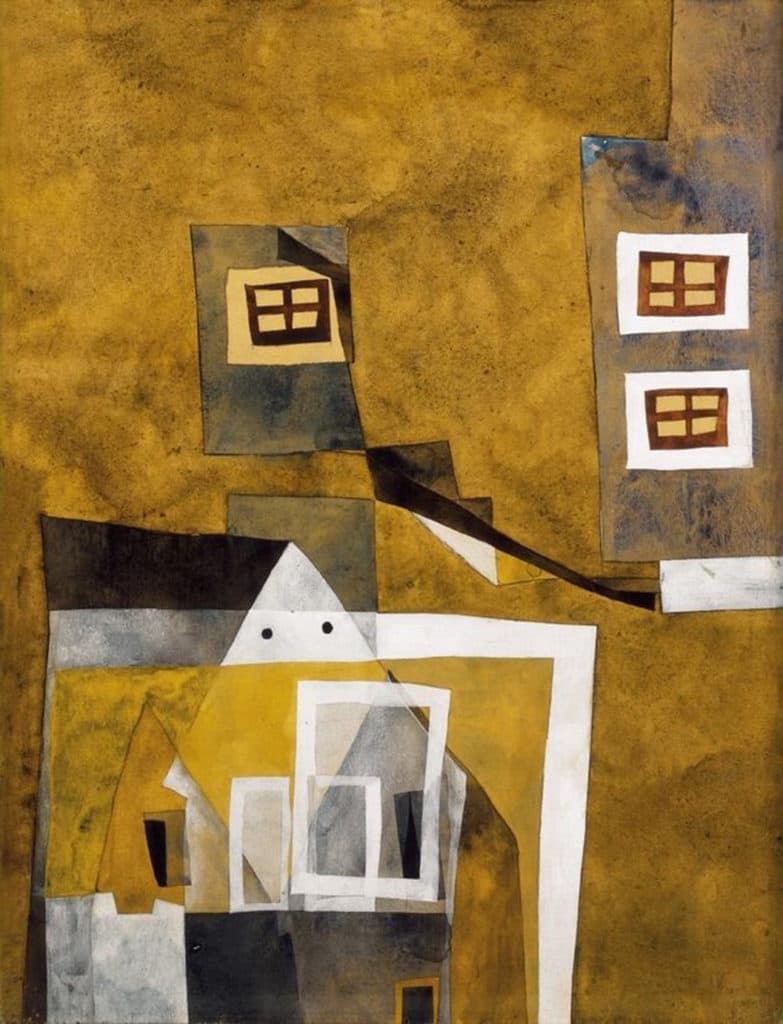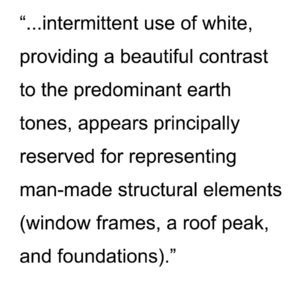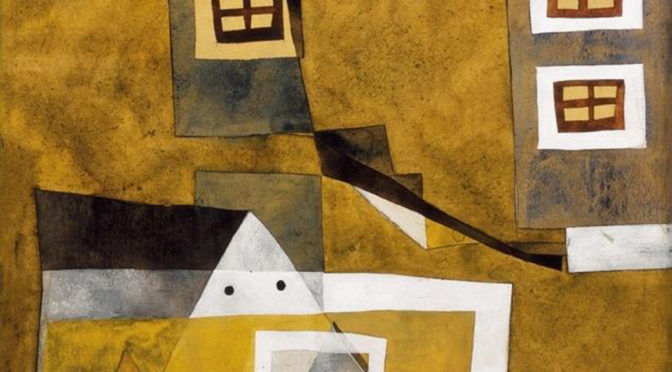
Floating Towards Jerusalem | The City in Art
by Dr. Mark David Major, AICP, CNU-A
Lajos Vajda’s Floating Houses (1937) is a personal favorite. Some sources describe Floating Houses as a surrealist work, which actually seems a better description about Vajda’s artistic circle (see below) than the composition itself. Instead, Floating Houses is better characterized as an avant-garde abstract composition that represents its subject (a townscape) liberated of gravity and dimensionally.
The only concession to gravity lies at the edge of the composition (i.e. canvas). This can be seen in the overlapping houses at the bottom and the inverted house form depicted along the right edge. This ‘gravity of the edge’ abstracts an invariant characteristic of urban form. There is a type of gravity associated with settlement edges, which is both economic and resource-based in nature due to the availability of (cheap) land. By definition, settlements grow at their edges. Floating Houses represents this invariant in a wonderfully inventive and whimsical manner. The only concession to dimensionally emerges from the two-dimensional plane of the canvas itself, most evident in the overlapping house forms at the bottom right. Many artists have played with the two-dimensional plane of the canvas in this manner for depicting an urbanscape. We will see some additional examples in subsequent articles during this series.
Vajda’s use of color for this composition also represents something rich about human settlements. Though the houses have been liberated from gravity and dimensionally in a free-floating environment, the predominant use of earth tones reiterates the unbreakable relationship of the settlement to the land, or man-to-nature.  The intermittent use of white, providing a beautiful contrast to the predominant earth tones, appears principally reserved for representing man-made structural elements (window frames, a roof peak, and foundations). This embeds Floating Houses with a dialogue about the man-nature didactic. Interesting, the use of white (a symbol of purity) for representing these man-man structural components may suggest a positivist perspective on this subject within the composition.
The intermittent use of white, providing a beautiful contrast to the predominant earth tones, appears principally reserved for representing man-made structural elements (window frames, a roof peak, and foundations). This embeds Floating Houses with a dialogue about the man-nature didactic. Interesting, the use of white (a symbol of purity) for representing these man-man structural components may suggest a positivist perspective on this subject within the composition.
For an artist noted for his use of religious symbolism, this might appear to be lacking in Floating Houses…. at first glance. Vajda’s use of four-pane windows and the resulting depiction of a cross might be incidental. However, since these cross forms tend to be framed by the white man-made structural elements, it is rather a subtle comment about religion being primarily a product of man than nature. If we accept this interpretation, then the artist also appears to concede a component of religion to the natural by using the darker browns (of wood, or nature) for the three crosses. In this context, the symbolism of the three crosses becomes significant, i.e. the Holy Trinity, Christ was crucified with two others (criminals) at Golgotha, and he rose on the third day. This introduces a dark undercurrent in terms of purity (Christ) and criminality (those crucified with him) for this representation of a townscape. Vajda then reinforces the message with the depiction of three paneless framed windows in white (good) and three voids represented in black (evil) at the center bottom. Finally, the most central part of the composition (white roof peak with two round voids) takes on an anthropomorphic quality that watches over the town (perhaps God or some other force). Taken together, this embeds Lajos Vajda’s Floating Houses with multiple layers of meaning and symbolism about Man, nature, and religion, good and evil, and town and country.
 About Lajos Vajda
About Lajos Vajda
Lajos Vajda (1908-1941) was a Hungarian avant-garde painter and a student at the Hungarian Academy of Fine Arts in 1927-30. He studied with Fernand Léger at Paris in 1930-34, where he was introduced to cubism and surrealism. Vajda collected folk art motifs for his artworks. He combined religious (Orthodox Christian, Roman Catholic, and Jewish) symbols, architectural and folk art motifs, abstract, figurative, and surrealistic elements on his art to create complex visionary images. He is considered the most distinctive artist of the Hungarian avant-garde movement. His art influenced generations of Hungarian artists including the members of the European School Art Group (1945-1948) and the Vajda Lajos Studio (est. 1972). Vajda died in a Jewish forced labor camp in the fall of 1941 at the age of 33 (Source: Wikipedia and American University).
The City in Art is a series by The Outlaw Urbanist. The purpose is to present and discuss artistic depictions of the city that can help us, as professionals, learn to better see the city in ways that are invisible to others. Before the 20th century, most artistic representations of the city broadly fell into, more or less, three categories: literalism, pastoral romanticism, and impressionism, or some variation thereof. Generally, these artistic representations of the city lack a certain amount of substantive interest for the modern world. The City in Art series places particular emphasis on art and photography from the dawn of the 20th century to the present day.

